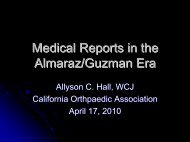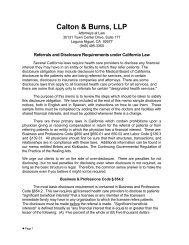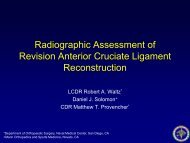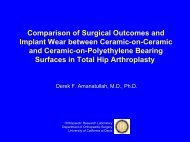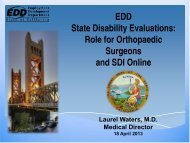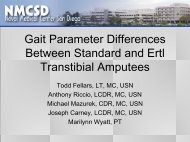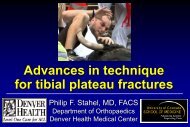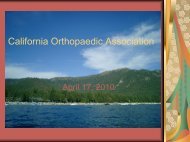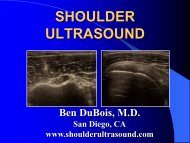• The physicians (particularly non-operative orthopaedists;see below) represent an excellent way to “test thewaters” when consideration is being given to adding toorthopaedic surgeon complement.• The physicians generate direct revenue for the practice.They also free up practice principals to perform surgery,which typically reimburses at a higher rate than work inthe office.• They allow for the generation of ancillary revenue,including (a) x-ray, (b) the sale of supplies, and possiblyeven (c) office procedures.• They can potentially expand subspecialty practice withnew products or services (such as pain management, andpre-surgical medical clearances) that may be in demandwithin the community.Note: non-physician extenders such as Nurse Practitioners(NPs), Physician Assistants (PAs), <strong>Orthopaedic</strong>Physician Assistants (OPAs) and Athletic Trainers (ATs/ATCs) have been incorporated into orthopaedic practicesfor a number of years to enhance surgeons’ efficiency inthe clinic and operating room. However, requirements forsupervision may limit their use and reimbursement undernew models of health care delivery. See Chapter 1: NonphysicianExtenders.DownsidesThe recruitment of non-surgical physicians also has certaindownsides.• Tension can arise if the physician wants to become apractice principal. Issues such as income distribution,on-call, and governance are sufficiently complicated evenin “homogenous” practices.• Care must be taken to be certain that there is a realneed in the community for the kind of physician whois recruited. Otherwise the practice will pay out asignificant amount of money and generate little netincome in return.• Physicians in the practice will need to agree on the scopeof practice for each non-surgical physician and utilizehim or her accordingly.• Unless employment agreements are constructed with anenforceable non-compete clause, employed doctors couldleave at the end of their contract and take patients withthem.• The practice must exercise care in developing marketingand promotion material (and in educating office staff)so that patients can make informed decisions regardingwhom they wish to see.Types of Non-operative Physiciansin <strong>Orthopaedic</strong> PracticesThere are several options for the addition of non-surgicalphysicians into a practice.Non-operative orthopaedic surgeons: <strong>Orthopaedic</strong> surgeonsmay choose to engage in non-operative practice fora variety of reasons. These include the decision to cut backas retirement age approaches; partial physical disability;personal/family commitments; or simply the decision tolive life with less stress and pressure. There are several advantagesof adding one or even more non-operative orthopaedicsurgeons to a subspecialty surgical practice. Sincethey do not perform surgery, they have a greater immediateavailability for new patient visits and consults. Because theyhave had previous experience in providing M/S surgicalcare, they are skilled in the assessment of patients who mayneed surgery and/or people who need to be seen on shortnotice for post-surgical concerns.Further, referring PCPs can be assured that their patientswill receive the same high quality of musculoskeletal careas they would receive from an operating orthopaedist.Finally, they provide timely initial fracture management forpatients referred from an emergency department or urgentcare clinic. Practices may choose to employ non-operativeorthopaedists during traditional office hours, or use them“after hours; e.g., early mornings, evenings and/or weekends.Physical medicine and rehabilitation physicians (Physiatrists):Physical medicine and rehabilitation physicians treatindividuals suffering from both minor and serious physicalinjuries and conditions. The core of a physiatrist’s trainingfocuses primarily on nerve, muscle and bone injuries as wellas illnesses that can affect these areas. Many physiatriststreat a broad range of conditions but some choose to focuson specific areas such as sports medicine, the spine or thepelvis. They can read and interpret MRI scans as well asperform epidurals and nerve tests (EMG’s). Physiatrists cantherefore generate several revenue streams for orthopaedicoffices and at the same time, allow practice principals to focuson surgery. The practice also benefits from an “image”standpoint because patients view the office as place to go toreceive care for a wide range of musculoskeletal conditions.Rheumatologists: Rheumatologists treat more than 200diseases and conditions, including rheumatoid arthritis,osteoarthritis, gout, lupus, back pain, osteoporosis andtendinitis. They also treat soft tissue problems related tomusculoskeletal system sports-related soft tissue disorders.The specialty is interrelated with the physical medicineand rehabilitation of disabled patients (see above) andphysiotherapy. As is the case with physiatrists, orthopaedicpractices employing rheumatologists benefit becausethese doctors generate revenue directly and allow practiceprincipals to focus on surgery. And again, the practice also12© 2011 American Academy of <strong>Orthopaedic</strong> Surgeons
enefits from an “image” standpoint because patients viewthe office as place to go to receive care for a wide range ofmusculoskeletal conditions.Other Non-surgical Physician Specialists: These includefamily practice sports medicine physicians, neurologists,endocrinologists and internists. These physicians serve asa referral source to orthopaedic practice principals andhelp to create an integrated care team for the treatment ofpatients with complex medical problems before and aftersurgery.To Recruit or Not to Recruit?Ultimately, the decision to recruit one or more nonoperativephysicians by a practice needs to be made basedon a variety of factors including its mission, geographiclocation, current orthopaedic physician complement, payermix, and the needs of the community. As stated in theBackground section above, it is critically important forthe office to develop a business plan for each practitioner.The plan should include qualitative issues such as whetherthe new doctor would enhance the practice’s image in thecommunity and improve the quality of life for practiceprincipals. It should also include a detailed pro forma ofwhat the financial impact might be of bringing the newdoctor on board. Elements of the pro forma include thefollowing:Income:1. Direct patient care revenue generated by the newphysician (but also see # 1 under “Deductions fromIncome” below)2. Direct revenue generated by the new physician resultingfrom additional ancillary services not currently providedby the practice (either because no current practiceprincipal is present to do so or because the servicesare outside the typical scope of routine orthopaedicpractice; e.g., epidurals)3. Additional revenue from surgery performed by practiceprincipals due to referralsDeductions from Income:1. <strong>Revenue</strong> no longer generated in the office by existingpractice principals (this is important and is oftenignored in financial projections)2. Non-operative physician salaries, benefits, professionalliability insurance and other overhead such asoccupancy3. Possible decreases in referrals from other doctors (e.g.,rheumatologists and physiatrists) whose businessincome has been adversely impactedSalaries for non-surgical physicians with the exceptionof non-surgical orthopaedic surgeons are available on linefrom sources such as www.salary.com. The median salary,for example, for a physiatrist is in the range of $200,000;for a rheumatologist, it is $185,000. Note that differentsurveys use different methodologies and statistics are notalways current. Also note that “Salary.com” and otherwebsites do not distinguish operative and non-operativeorthopaedic surgeons. The AAOS Research Departmentdoes collect this information via the Census (<strong>Orthopaedic</strong>Practice in the U.S.). It is available to AAOS membersupon request: oracle@aaos.org.Obviously, whatever salary is ultimately offered to anemployed non-surgical physician will depend on factorssuch as experience, number of hours worked per week andnumber of weeks per year, number of patients seen, andanticipated reimbursement from payers and patients. If thepractice offers excellent benefits (including contributions topension and profit sharing), this should also be consideredbecause what is important is the total package, not just theperson’s paycheck.Contact: James Keeney, MD: jimkcon@sbcglobal.net© 2011 American Academy of <strong>Orthopaedic</strong> Surgeons13




